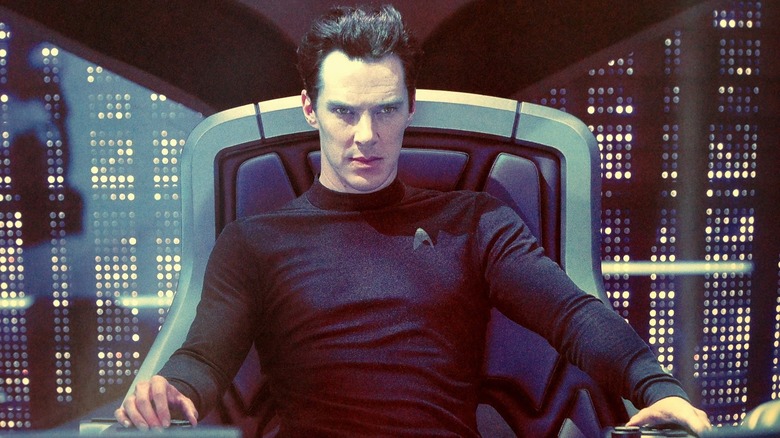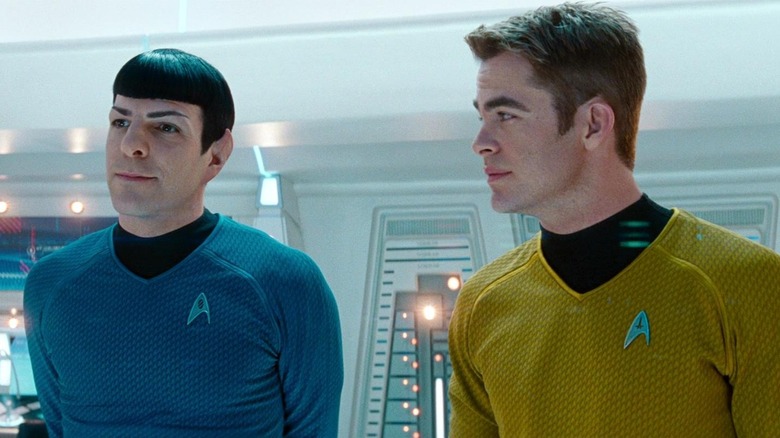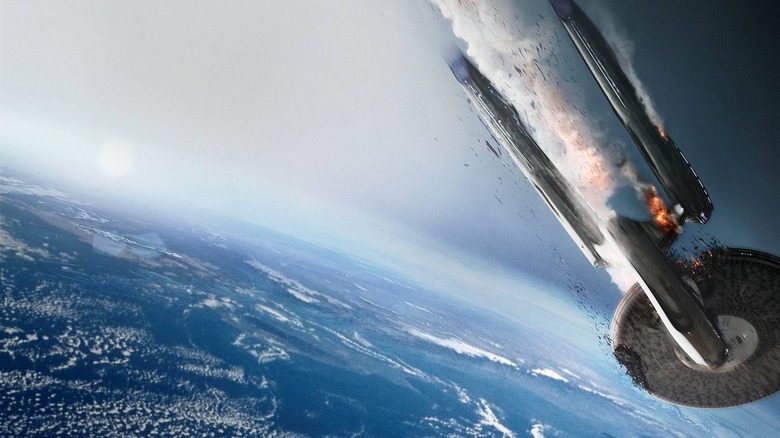The Plot Of Star Trek Into Darkness Had To Live Up To Its Price Tag
Making effects-based genre blockbuster movies must be a chore. In addition to wrangling and scheduling a large cast of known actors, who are likely being courted by other projects constantly, one must build sets, arrange international teams of CGI artists to develop the VFX, and shoot under a strict timetable, all while deflecting journalists and responding to constant input from a studio that keeps your budget in its fist, wondering if story elements, visuals, dialogue, or actors be changed to fit their vision on what will make them the most money. The leeway for personal creativity must be measured using a zero and many decimal places.
This must especially be true when dealing with sequels or franchise pictures that must adhere to a known visual template, an existing cast, already-made costumes, and — in some cases — pre-staged action sequences that were likely in development before the director signed on. Writing blockbusters is an exercise in pliability, in learning to come up with an exciting story, and then altering it every day to match the input from executives. For every credited screenwriter on a large-scale studio film, you can bet there were at least a dozen other writers who had a hand in the final draft.
Additionally, there must be pressure to justify the enormous budgets allocated to such projects. When the studio is willing to spend $100 million on a film, it would be antithetical to come up with an idea that only requires $30 million.
Several of the above points were issues for co-screenwriter Damon Lindelof, one of the writers of the 2013 sequel "Star Trek Into Darkness," co-written with Roberto Orci and Alex Kurtzman. Lindelof one of the showrunners on "Lost," and the screenwriter on "Tomorrowland" and "Prometheus," and he has discussed the pressures of a big budget, and what sort of unwritten mandates he held himself to while making Trek 12.
You have to save the world
"Star Trek" faces a screenwriting dilemma when it comes to big-budget movies. The various Trek shows were always strongest when tackling difficult ethical and philosophical issues. In scaling such stories up for the big screen, one might discover an outsize visual aesthetic or action scenario is not needed. As such, the stakes have to be raised to fit the inflated budget. A $100 million production cannot merely go about debating how Data might be human, or the fineries of the Prime Directive. The fate of a planet must be involved. And what planet to Earthlings know better than Earth? Lindelof elucidates:
"Once you spend more than $100 million on a movie, you have to save the world. And when you start there, and basically say, I have to construct a MacGuffin based on if they shut off this, or they close this portal, or they deactivate this bomb, or they come up with this cure, it will save the world — you are very limited in terms of how you execute that."
Lindelof explains that this is a very limited way of doing things. And that mounting stakes over the course of a generation have trapped the way one can write these movies:
"[I]n many ways, you can become a slave to it and — again, I make no excuses — I'm just saying you kind of have to start there. In the old days, it was just as satisfying that all Superman has to do was basically save Lois from this earthquake in California. The stakes in that movie are that the San Andreas Fault line opens up and half of California is going to fall in the ocean. That felt big enough. But there is a sense of bigger-better-faster-seen-it-before-done-that."
The Avengers aren't going to save Guam
For a mainstream American audience, the stakes must be, as Lindelof continues, mainstream American. A "Star Trek" film cannot save a random populated planet that contains a civilization we never see. These were the stakes in 1994's "Star Trek: Generations," and while saving billions of people is a noble goal for an adventure story, it would help if the audience had an emotional — and not merely an intellectual — connection to them:
"It sounds sort of hacky and defensive to say, [but it's] almost inescapable. It's almost impossible to, for example, not have a final set piece where the fate of the free world is at stake. You basically work your way backward and say, 'Well, the Avengers aren't going to save Guam, they've got to save the world.' Did 'Star Trek Into Darkness' need to have a gigantic starship crashing into San Francisco? I'll never know. But it sure felt like it did."
Prior to the release of "Into Darkness," Lindelof also revealed to Collider a rule he wanted to follow, even if there was no written decree. Although there are many beloved planets and species throughout Trek history, Lindelof felt it important that Earth be heavily featured, and that they spell out the premise of Trek to the (presumably very few) people in the audience who might have confused it with "Star Wars":
"I don't want to get into percentages of how much takes place on Earth and how much takes place off Earth, suffice to say I think one of the things we felt a lot of people didn't know about 'Star Trek' was that they didn't think that 'Star Trek' was the future."
Not the future? What? He went on:
"You take something like 'Star Wars,' 'Star Wars' is not the future. It's a long time ago in a galaxy far, far away. And Luke Skywalker is not a human being and isn't from the planet Earth. The idea in 'Star Trek,' they are. They're in the 23rd century and these people are from Earth. The Earth needed to play more of a role in these movies, especially in the sense of giving the audience a degree of relatability. I think that in the same way that New York City becomes this anchor point for people in the Marvel movies; that's Spidey's stomping ground, that was the stomping ground for Tony Stark, that was the stomping ground for The Avengers, it's New York. We wanted to do the same thing with Earth in the 'Star Trek' movies.
Even the most casual Trekkies can, of course, differentiate between Trek and "Star Wars" movies, but I suppose one can take his meaning. As the audience is made of humans from Earth, then the story of "Into Darkness" should center on humans from Earth.
"Star Trek Into Darkness" ultimately had a reported budget of $190 million, and would go on to earn $467 million worldwide. It led to another sequel in 2016, "Star Trek Beyond," and a 14th Trek film is currently in production. Lindelof would go on to write "The Hunt" and the "Watchmen" TV series. In 2014, he did a very wise thing and quit using Twitter.


